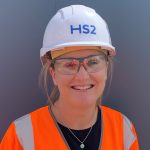St Mary’s Church: demonstrating the limitless possibilities and value of on-site archaeological public engagement in construction projects
The St Mary’s Field Museum programme of events demonstrated that it is not only safe and secure to invite members of the public on to a construction site, but that doing so adds great public value and creates a lasting, treasured legacy as a result. Such events provide the opportunity for the public to be involved in an archaeological site, to see their local history being excavated in real time, and to engage directly with the archaeologists undertaking the work. It is also an opportunity for archaeologists to impart key skills and knowledge into communities that can be used and passed on long after the project has ended.
Engagement in this manner can also lead to a change in public perceptions of a scheme, helping visitors to see current development as part of continuous landscape change.
Changing negative perceptions into positive is a rare achievement for a construction project and the value archaeology can add to a scheme through public engagement should not be underestimated.
Archaeological public engagement in construction projects benefits the local community but it also benefits the project, especially in terms of positive perception. Taking the opportunity to hold large scale archaeological public engagement activities on site results in a lasting, treasured legacy for the local community, adding a great amount of public value to HS2, and construction projects in general.
The St Mary’s Field Museum was a public engagement programme held between May and September 2021 during HS2 excavations at the site fo St Mary’s Church in Stoke Mandeville. This paper discusses how the public were invited into the excavation site to take part in open weekends, educational courses, and to engage in open conversation with the archaeologists excavating the site. The holistic process of constructing the Field Museum and its programme, benefited greatly from early involvement of health and safety and security teams. Combined with a collaborative desing process involved public engagement specialists, archaeologists and an architect allowed a bespoke product to be presented to the public in the form of the Museum, facilitating the archaeologists in exploring the site and its history with the public. This was all undertaken during the peak of the COIVD-19 pandemic.
The success of St Mary’s Field Museum demonstrates that this type of engagement can take place in a safe and accessible manner, and that the opportunities provided are greatly apprecaited by the local community. Such events also provide the opportunity for up-skilling the next generation of archaeologists through educational courses. This paper also illustrated how the St Mary’s Field Museum used innovative and interactive methods of public engagement to sensitively present the excavation of the church and churchyard to the public.
It is clear from the feedback received at St Mary’s Field Museum that there is a desire from the public for further public engagement around the archaeology of HS2, and the Field Museum model provides a proven format for future public engagement programmes.
The learning legacy of the Field Museum at St Mary’s has demonstrated that with a collaborative and open-minded approach from key departments, on site public engagement is possible, safe, secure and invaluable to a scheme and the local community. This paper outlines how it was achieved at St Mary’s, the value of such events and the limitless possibilities and contributions they can make.
Introduction
The St Mary’s Field Museum was a community engagement project held alongside excavations at the site of the former parish church of St Mary in Stoke Mandeville, from May to September 2021, as part of the Enabling Works Contract (EWC) on the central section of High Speed Two (HS2) Phase One, delivered by Fusion Joint Venture (Morgan Sindall, BAM Nuttall, Ferrovial Agroman) and archaeological subcontractor L-P: Archaeology. St Mary’s Field Museum built upon the success of a previous iteration of the Field Museum held at the same site in November 2018. The 2018 Field Museum comprised a three-week programme of community engagement, consisting of two Open Days and three weeks of three-day and one-day “Experience Days”. The 2021 Field Museum operated on a larger scale consisting of:
- Seven Open Weekends with a total of 1,560 visitors. They ran between May and September 2021 with one weekend running as part of the Festival of Archaeology 2021.
- Four Heritage Skills Courses with a total of 97 participants. These were held two days a week throughout July and August 2021. They focused on elements of archaeology related to the church including osteology and graffiti recording.
- The graffiti recording course was adapted into a pack used by Aylesbury and Chilterns YAC (Young Archaeologists Club) as an off-site graffiti recording workshop.
- Six update films, following progress onsite during the church and churchyard excavations. These are available to view on the HS2 YouTube channel.
- There were two events which were aimed at 14 – 18-year-olds, a one-day work experience and careers programme (Insight Day) which ran on 2nd August 2021 with 39 participants, and a careers talk at a local secondary school on 15th October with 23 participants. Both were held remotely online due to the COVID pandemic.
- Three site visits arranged for Buckinghamshire Archaeological Society with a total of 38 attendees. Two were held during the week on 9th May and 15th July and the third was held during an Open Weekend on 25th September.
- Nine Curriculum-linked School Resource Packs were produced. These were designed to be used at primary and secondary school levels and are available for download on the HS2 educations resources website.
St Mary’s Field Museum was different from a pop-up style museum as it was located at the heart of the site. Whilst a pop-up museum is presented away from the site, the Field Museum means that visitors could view the site as part of their visit and take part in educational courses whilst the excavations were in progress. Those attending the courses said they felt like they were part of the excavations as a result, especially when an archaeologist brought round an interesting new find whilst the course was in progress.
Space and accessibility
The Field Museum was designed as a self-contained 50m x 15m space within the tent which covered the excavated extent of the church and churchyard. The purpose of the tent was to screen the excavation of the burial site from view as well as to protect the excavations from the elements. Some visitors came with the sense that the tent was “hiding” something, but once they entered the Field Museum and climbed the viewing platform, they were able to see that this was not the case. This was very beneficial for the local community, many of whom, in their feedback, thanked the archaeologists for the chance to see the site. A view of the field museum with the viewing platform on the left is visible in Figure 1 below.
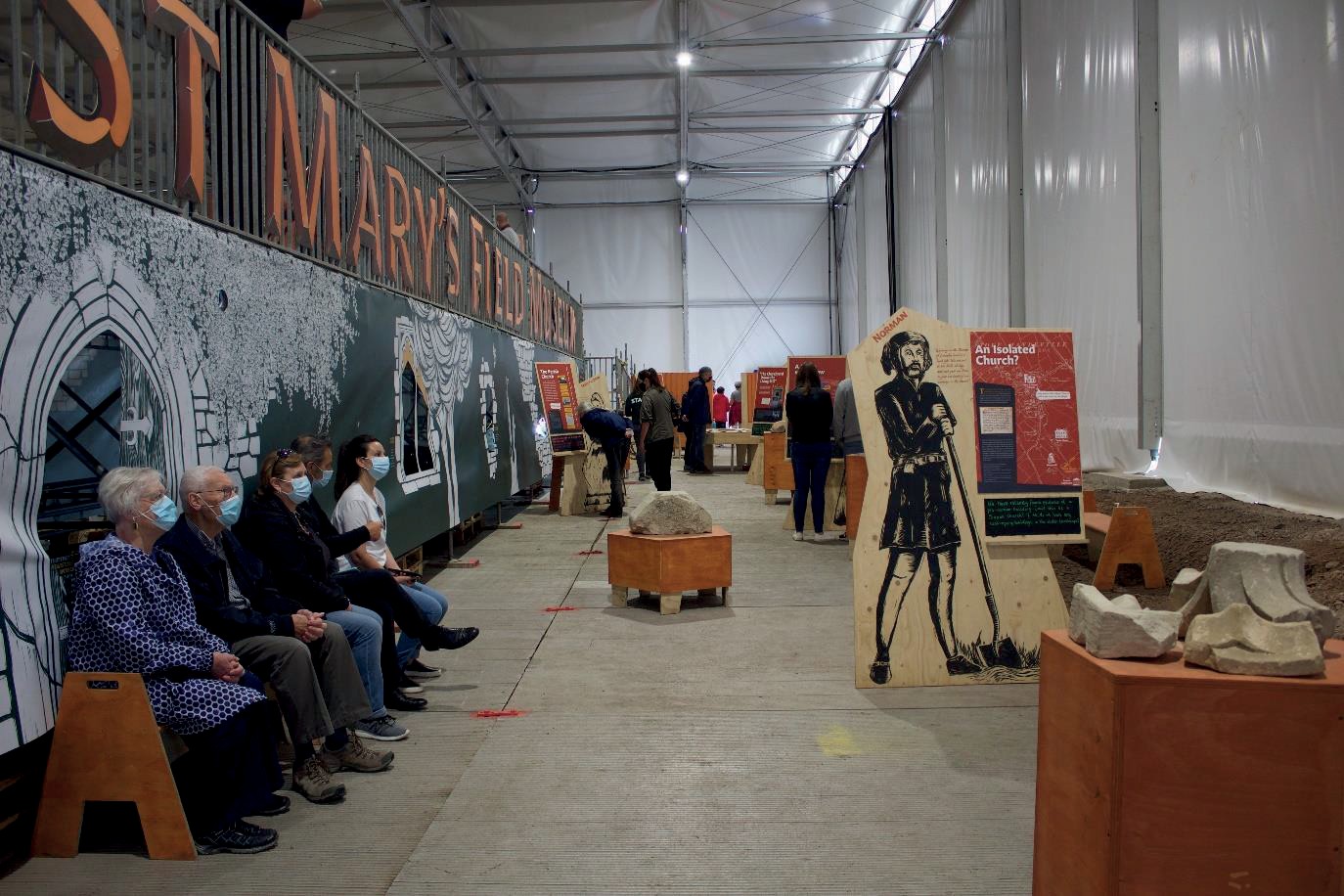
However, the tent did create a feeling of disconnection between the church and its wider landscape. Therefore, innovative methods had to be used within the Field Museum to help people understand the importance of the wider landscape both in the archaeologist’s interpretations of the uses of the site, but also in understanding how the site looked throughout the past. A 3D model of the church and its surrounding landscape was created to a brief by architecture students from the University of East London. Using this model table, archaeologists were able to talk about the history and archaeology of the site in its wider landscape context. By showing a continued place but with change in the use of space over time, it was also possible for archaeologists to help visitors see current development as part of continuous landscape change.
The design of the Field Museum was a collaborative process, working with an architect and graphic designed to develop a space that was accessible and contained interactive elements that would appeal to a wide range of visitors. The Field Museum had a cohesive design and colour scheme, recognisable to visitors and would identify the St Mary’s Field Museum. The main aim of the Field Museum was to provide participants with a valuable learning experience, investigating and appreciating multiple aspects of their local heritage. The Field Museum was designed as a space for placemaking, where local people could come together to gain a deeper understanding of their local area, and somewhere to which they would want to return.
The interior of the Field Museum was designed to be reconfigured, creating a learning space for the Educational Courses which was distinct from the museum space (Figure 2).
Freestanding interpretation boards could be moved around to create the illusion of walls, creating a new learning space for the heritage skills courses. All elements of the museum were made of lightweight materials, allowing them to be moved by one or two members of staff.
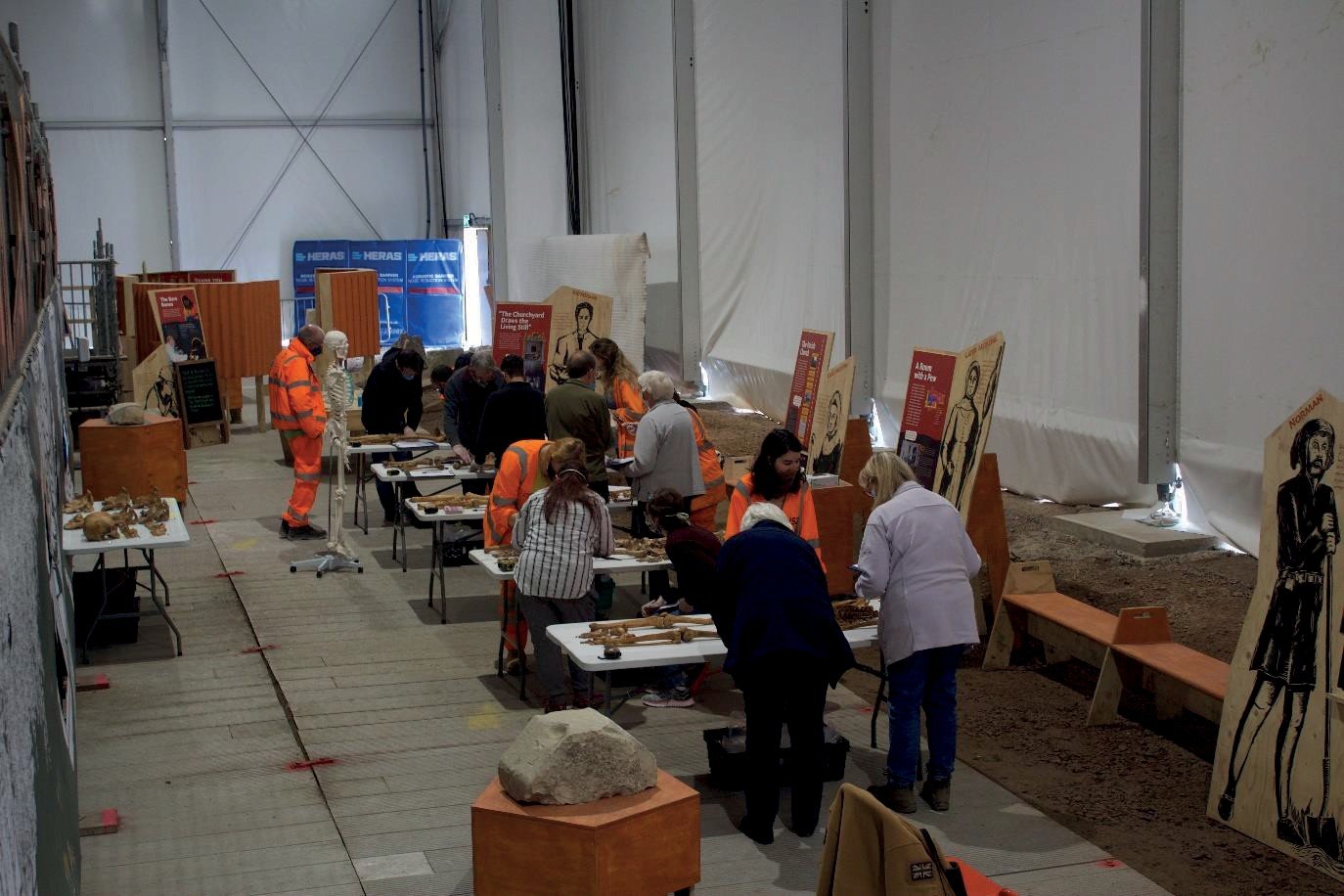
The excavation area was screened off from the museum with a specially designed scaffolding wrap covering the base of the viewing platform. The separation of the works area from the museum meant that visitors were not required to wear PPE even for the weekday courses, and that staff in the museum could wear specially designed t-shirts, making them recognisable but also approachable by visitors. The screening of the excavations site from view was required by the Undertaking between the Secretary of State and the Archbishop’s Council of the Church of England. This required that the human remains be afforded dignity, care and respect from casual observation. Undertaking and Assurance (U&A) stated by the Archbishops’ Council in the HS2 Act, therefore visitors ascending the viewing platform and viewing the churchyard (including empty grave cuts) were doing so with informed consent. The viewing platform ran the full width of the tent, facing the excavations, and consisted of a scaffolding platform approximately 2m high. It was reached via ramps at either end of the main Field Museum area. Visitors were warned that grave cuts would be visible from the vantage point both in writing (in the Terms and Conditions document emailed to them as a booking confirmation) and again when entering the Field Museum.
No human remains were visible or on display within the Field Museum (or in the excavation area during public visits). Whilst photographs of human remains under laboratory conditions or for publication were permitted through discussion with the HS2 Burial Grounds Coordinator and the Archbishop’s Council, the decision was made not to include them within the Field Museum. This decision was taken out of respect for the local community and for those buried in the churchyard. As the last burial at St Mary’s was interred in 1908 it was evident that there may be visitors to the Museum who could be close relatives of those buried in the churchyard. Many visitors commented that they were pleased to see how sensitively the excavations were being carried out. With one visitor comments “so much respect shown to the church and people”.
Not showing images of human remains did not mean that the Field Museum avoided the topic. Instead, it addressed it in an innovative and sensitive manner. As well as an interpretation board which explored the process of osteology at St Mary’s, an interactive skeleton puzzle was created (Figure 3). This was inspired by medical drawings of the human skeleton, rather than a hyper-realistic image of human skeletal remains. The puzzle was aimed at engaging children of all ages. For young children it was a game where they could put the shapes in the correct slot. For older children they could learn the scientific names for the individual bones as they identified the correct place for each piece. Both of these groups were looking at the puzzle as “what bones are in our bodies”. The decision of whether this could lead to a discussion with the children of what happens to our bodies after death was left to their accompanying adults. For older children and adults the puzzle highlighted examples of pathologies on some of the bones. These pathologies were accompanied by questions encouraging visitors to think about how osteologists examine bones and how people’s lives can leave evidence on their skeletons.
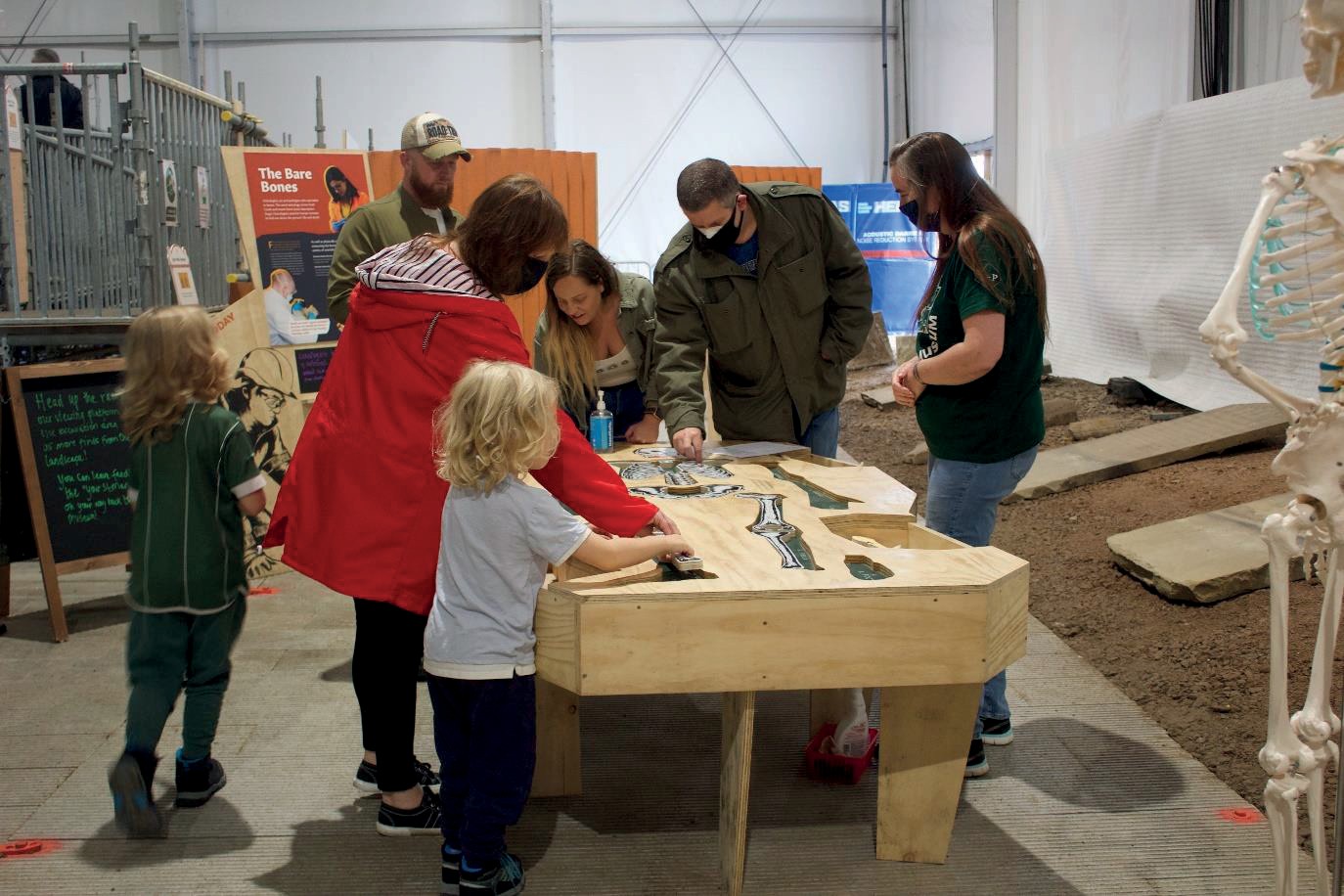
This interactive element of the museum helped children engage and develop their knowledge and understanding with many picking it as their favourite part of the museum:
“I liked the bild [sic] a body”
“We had a great time doing the skeleton”
“The sceliton [sic] was very cool and I have already learnt stuff”
Whilst the skeleton table was primarily designed for children it was also enjoyed by adults with many of them commenting on it in their feedback:
“The skeleton table interested me… the highlighting on injuries is something I’d not really appreciated before”
The skeleton puzzle was accompanied by an anatomical skeleton model for anyone who wanted to extend their understanding.
There were other interactive elements introduced into the museum during the Open Weekends. As visitors could not enter the excavation area for health and safety reasons, artificial reality and virtual reality technologies were employed to create a 360 degree walk around the archaeological site. This was shown on a screen and allowed visitors to experience being inside the excavation area. Moving around the site, it was possible to click and view historic photographs, as well as images from the excavation, so visitors could visualise how the site had changed over time, including the decline of the church into ruins, and the progress of the excavations.
A 1:40 scale Lego model of the church (Figure 4) was designed and built by an archaeologist working on the site using historic photos as well as archaeological evidence. The model helped people visualise how the church looked before it fell into ruin as well as demonstrating the archaeological process. This was very popular with visitors:
“I loved the Lego model, I wish I had one like that” “Lego is cool so its 10/10”
“loved the Lego model to help me visualise the layout better”

St Mary’s Field Museum met with all Equality Act (2010) guidance, being designed to be fully accessible and step free:
- The doors were 1.7m and 1.9m wide with the entrance being ramped.
- The free-standing boards and plinths were spaced to allow free movement of wheelchairs and prams.
- The access ramps for the viewing platform were coated with a non-slip material and had edge protection.
- Accessible parking and toilets were provided, as was seating throughout the museum.
- All video content was shown with subtitles and large print text of all content was available.
- Information was provided in a range of learning styles, including tactile models and interactives, text hierarchies and accessible language.
- Online information including videos were available through the HS2 website and YouTube for those who could not visit in person.
There were two issues with accessibility encountered during Open Weekends. Firstly, face masks caused difficulties in communication for Deaf visitors and those with a hearing impairment. Clear face masks could have been used to allow for lip reading without staff having to remove their masks. Secondly, large print versions of boards were available, but members of the public had to ask staff for them. In future it would be better to have large print versions located with the relevant boards.
The exhibition space contained ten A1 sized free-standing interpretation boards which focused on different elements of the site’s history and excavation. Six of these interpretation boards had accompanying character panels. The character – representing Roman, Norman, Later Medieval, Early Modern, Victorian periods as well as an Archaeologist – told the story of the site throughout time. These were both engaging for younger children and drew people in to look at the boards. The characters were designed to demonstrate the diverse population of Stoke Mandeville in the past, including women, elderly, and people with disabilities. The interpretation boards were pitched for a reading age of 9 and included a lot of images. They did not require visitors to have prior knowledge of archaeology or local history. Below the printed board was a chalkboard which could be updated to provide further information throughout the excavation. The Field Museum was designed to be updatable, in order to reflect changing interpretations and new discoveries as excavations progressed.
Chalkboards were updated for each Open Weekend. New artefacts were added to the finds cases, and the film reel was updated with new time-lapse footage to reflect the current stage of excavations, as well as with the update films as they were released by HS2. Visitors also contributed to the exhibits. A section of the museum called “Your St Mary’s” was designed as a hub for collecting oral history, as well as a space for visitors to share thoughts, feelings and memories (Figure 5).
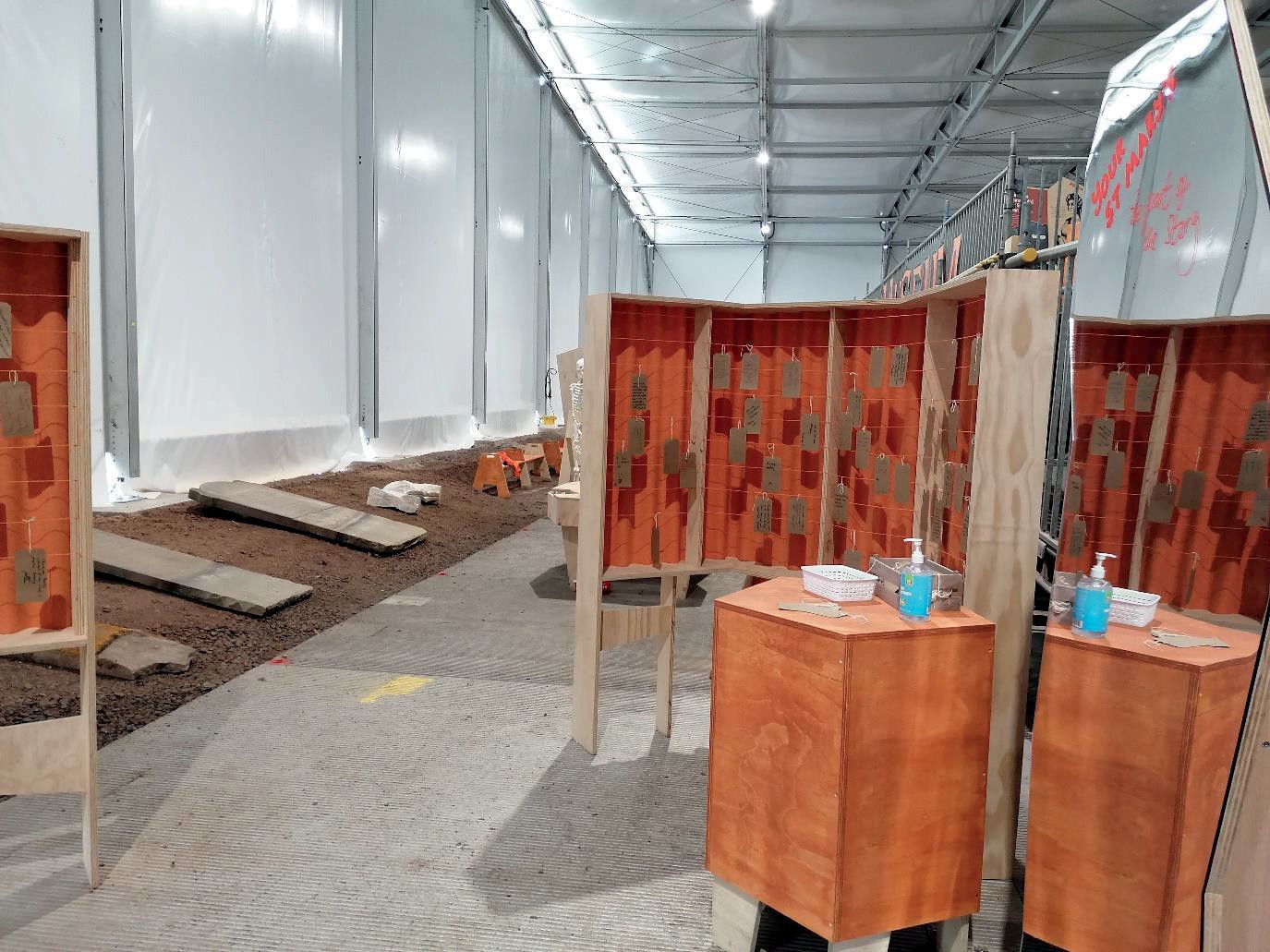
COVID-19
Opening and running a public event during a global pandemic was no easy feat. The Field Museum team worked closely with our Health and safety teams to ensure that the Field Museum could be opened, in line with Government guidance, but primarily safely for all public and staff involved.
According to Government guidance museum spaces could be opened from 17th May 2021. The first Open Weekend was therefore planned for Saturday 29th and Sunday 30th May 2021.
Many safety procedures were implemented to make sure the Museum events (Open Weekends and Educational Course) were COVID-safe for everyone involved. These can be broadly split into two categories: those physical actions that were taken throughout the Museum, and the advice given to members of the public attending. The latter was given through Terms and Conditions on booking their slot as well as at check in on arrival at the Museum by welcome staff.
The Terms and Conditions were emailed to attendees ahead of each event. They gave reassurance by setting out what the Museum staff were doing to make the event COVID- safe. “What to expect from us” stated:
- We will follow the latest government guidelines – your visit could be cancelled or postponed at short notice if guidance changes.
- We will always remain 2 metres apart from you following social distancing guidelines and wear a face mask at all times.
- We will provide signage for and enforce a one-way system through the museum.
- We will provide first aid and emergency care for you if required. In an emergency we may not be able to maintain social distancing, staff providing the first aid will wear appropriate PPE.
- If a member of our staff assisting your visit becomes unwell within 2 weeks we will inform you.
The Terms and Conditions also set out what was expected from members of the public, to ensure COVID safety. “What we expect from you” stated:
- If booking on behalf of others within your family/bubble, please make them aware of the safety requirements for visiting this archaeological site and share this statement with all members joining you on your visit.
- Following government guidance regarding COVID-19 when you visit. Face masks are required in indoor spaces (unless exempt under government rules) so please bring one with you.
- Social distancing is compulsory, please remain at least 2 metres apart from staff, volunteers and other group participants (unless they are part of your family/bubble).
- You remain responsible for arranging your own travel and checking all relevant risk assessments for travel are in place if required.
- If you or someone within the group becomes unwell within 2 weeks you will inform us immediately.
The terms and conditions document also stated that members of the public must not attend if they have symptoms of COVID-19. As tickets were free any cancellations would not have resulted in any charge or fee, which again was clearly stated in the Terms document. The same points regarding COVID-19 were issued in the Terms document for the Educational Courses.
On arrival into the Museum, attendees were asked to check in to the venue using a QR code generated by the NHS Track and Trace app. A spare book of fresh facemasks was also available for anyone who did not bring their own. Visitors were reminded to wear the masks (unless exempt) and remain socially distanced throughout the duration of their visit. The
one-way system was explained on arrival and indicated on the floor with clearly painted arrows.
Other physical safety measures included hand sanitiser stations at the entrance and at regular intervals throughout the Museum. The public accessed the Museum on specified timeslots with a 30minute gap in between. This time was used to wipe down key touch points with sanitiser spray around the museum including the skeleton puzzle and handrails on the viewing platform.
As the Government restrictions lifted and the UK exited all restrictions, the Museum and its events still operated under the safety measures outlined here. The only change was to the social distancing. This was reduced from 2 metres (20 visitors per hour), to 1 metre allowing 40 visitors per hour to access during the Open Weekends. The numbers of attendees to the courses were not affected by this change as it was dictated by quality of learning rather than COVID rules.
Whilst there were a proportion of unexplained no-shows (usual for free events) there were no reported cases of COVID-19 amongst members of the public or staff, following their visit to the Museum / Educational Courses. The visitors also complied easily with the guidance and were clear and comfortable with all the COVID safety measures.
The measures and the Terms document issued to the public were reviewed and approved by the relevant COVID safety committee, with all Health and Safety teams also on board. Whilst the COVID pandemic caused changes to the way in which the Museum was forced to operate, it did not impact the value of the event or the enjoyment of the visitors. The teams involved reacted to the pandemic with tenacity and innovation, resulting in a COVID safe museum.
Health, safety and security
One of the key outcomes of this event was demonstrating that it is safe and secure for all involved to invite large numbers of members of the public on to a construction site to take part in archaeological community events. This was achieved through careful and detailed planning with the cooperation and involvement of many departments.
A specific risk assessment document was created to cover the aspects of the Museum events. This detailed how the visitors were to engage with the site during their visits. In order to ensure the public understood what was required of them, details were included in the Terms and Conditions document issued to them as part of the booking confirmation. Simple things such as no pedestrian access, the need for sensible and sturdy footwear, children to be accompanied, and no pets were stated. On arrival visitors were directed to park in the main site car park and then further directed by members of the security team along a fenced path to the Museum entrance. The routes to / from their vehicles and the museum area itself were all fenced with metal barriers to ensure no member of the public could access any area of the site which remained off-limits. All machinery and tools were removed from the inside of the tent for the duration of the Open Weekends.
Early and detailed involvement of the Health and Safety and Security teams at both Fusion- JV and HS2 Ltd meant that safe and secure methods were established in order to ensure the smooth running of the events. All decisions on visitor numbers, pedestrian routes, security checks etc., were taken with the involvement of all the teams – it is only with this collaborative approach that it was possible to hold the events safely, with up to 400 people attending at any one time, and during the middle of a global pandemic.
Public and social value
Public engagement and outreach can bring benefits to local communities which are more immediately felt than the wider benefits of improved transportation or sustainable development. It is becoming more widely accepted within the construction industry that public benefit is not just to be found in the development of public knowledge and understanding about history and archaeology, but also in improved community wellbeing and cohesion (CIfA 2021:4)[1]. The opportunity to participate in archaeology and heritage projects also helps individual wellbeing, helping participants gain new skills and offering a new perspective on their local area. This can leave them feeling more connected to the wider community and give them confidence to try new things and use their new skills to share knowledge with others. St Mary’s Field Museum was a place where members of the local community could ask questions, develop their sense of place, learn about the history of their area, and make a contribution to the Field Museum by sharing their experiences and memories with the archaeologists (Figure 6).

The public engagement programme at St Mary’s engaged over 1,700 people through visits to the Open Days and the Educational Courses. A further 10,000+ people were engaged through update videos hosted on the HS2 YouTube channel. Feedback from participants was hugely positive, with 96% of visitors saying it had inspired them to learn more about archaeology and the programme was successful in meeting its aims and objectives.
An immediate outcome of the Field Museum was improved community feeling as it provided answers to local residents’ questions. Further social benefit was gained as visitors developed a deeper understanding of their local history, strengthening their connection with the local area:
“Good resource for Stoke Mandeville residents” “I had no idea about the archaeology in this area”
“HS2 has massive negative press – sites like this redress the balance with positive approach to local history”
Demonstrable short, medium, and long-term outcomes of the St Mary’s Field Museum public engagement programme. These are outlined in Table 1 below.
| Short Term | Medium Term | Long Term |
|---|---|---|
| Awareness, learning, knowledge, skills, motivations | Actions, behaviours, decisions, policies, practice | Contribute to larger scale changes at economic/social/environmental level |
|
Increased awareness of archaeology in local area |
Encourages similar engagement at other sites |
Insight day/careers talk participants go on to study or work in the sector. |
|
Furthering knowledge of Stoke Mandeville in the past (local history) |
More people know about local history/archaeology, more likely to visit other heritage sites and engage with archaeology along HS2 line |
Other visitors such as course participants go on to study/work in the sector |
|
Returning/intending to return to find out more |
Course participants build on experience through volunteering, societies, study and work experience |
Social benefit recognised and changes public engagement across HS2/archaeology |
|
Telling others about the Field Museum |
Build on experience to develop better public engagement. |
People more generally invested/interested in local history and preservation of archaeology and historic environment. |
|
Course participants CIfA Accredited certificates |
BAS graffiti survey |
The project was successful in meeting all five HS2 Historic Environment Research and Delivery Strategy (HERDS) specific objectives for community engagement as mapped in Table 2 below.
| HS2 HERDS Community Engagement Specific Objective | Contribution |
|---|---|
|
CE1: Marking and communicating the changes to landscapes and environments |
The Field Museum demonstrated to visitors how the landscape of St Mary’s changed over time, showing evidence of landscape use from the Roman period to the present day. The model table produced by architecture students from UEL was used to show how the church and churchyard were altered over a c.1000-year period. “Your St Mary’s” encouraged visitors to share their own experiences of landscape change through their memories of the church and churchyard, especially before and after St Mary’s was demolished in 1966. |
|
CE2: Identifying and sharing our stories |
The Field Museum provided visitors with the means to discover the history of Stoke Mandeville, through the historic landscape. This was relayed to the public verbally and through interactive activities as well as interpretation boards. “Your St Mary’s” encouraged visitors to become actively involved in curating and sharing their own history and memories |
|
CE3: Meeting the challenge of inspiring the next generation |
The Field Museum provided visitors with the means to discover the history of Stoke Mandeville, through the historic landscape. This was relayed to the public verbally and through interactive activities as well as interpretation boards. “Your St Mary’s” encouraged visitors to become actively involved in curating and sharing their own history and memories. |
|
CE4: Accessible information and knowledge sharing |
Digital technologies were used to communicate effectively with the public. Video update films were able to reach a wide audience of over 10,000 people. 360 degree technology was also used to capture the site and the Field Museum, to create a virtual tour which could be accessed online, as well as viewed on a screen in the Field Museum. |
|
CE5: Contribute to the process and facilitation of audience project creation |
The CIfA accredited heritage courses equipped local people with skills to continue to explore and record their local history. Taking part in the graffiti course, with the training and resources provided, inspired members of Buckinghamshire Archaeological Society to begin a volunteer project recording church graffiti all over Buckinghamshire. |
Based on the aims and objectives for the public engagement programme (as set out in the Project Plan), five Key results (KR) for visitors and participants were also developed and fulfilled. These were adapted from the Arts Council England Inspired Learning for All (ILFA) framework[2]. These are set out in Table 3 below.
| Key results (KR) for visitors | |
|---|---|
| KR1: People have an enjoyable visit that inspires them and gives them a feeling of enrichment. |
Very positive feedback from visitors, both verbally and written. 34% of visitors had heard about the Field Museum through “word of mouth” suggesting that visitors told other people they had enjoyed their visit, and inspired others to visit. |
| KR2: People use the Field Museum to develop their knowledge and understanding of archaeology and local history |
88% of visitors said they had learnt something new. Some commented they were surprised how much they had learnt, whilst for others it was the first time they had visited an archaeological site. |
| KR3: People develop their skills and learn new ones. |
97 participants in heritage/educational courses. All said they had learnt something new during the course. |
| KR4: People become motivated, questioning and open to different perspectives. |
Participants on the graffiti recording course motivated to begin a county recording project. A few visitors to the Field Museum expressed an intention to ask “difficult questions” when they arrived, however, all left having enjoyed their visit and “difficult questions” completely forgotten. |
| KR5: People become inspired to do something different in their lives/careers. |
Two participants on the Educational Courses signed up for further archaeology courses: one degree and one diploma. Two visitors to the Field Museum went on to gain work experience in commercial archaeology. |
Visitors expressed a desire for other similar public engagement projects in the future and even further excavations in the local area:
“It would be nice to think that some kind of archaeological examination could continue into the area beyond the present site.”
“There should be more events like this on other building sites. It’s a fascinating look into the past right on our doorstep.”
“I would like to visit more of these.”
“Would love to see HS2 doing more events like this at other sites.”
The heritage courses equipped local people with skills to continue to explore and record their local history. Participants particularly enjoyed the practical element of the courses which they felt really enhanced their knowledge and understanding and gave them confidence to use and develop those skills in the future. Taking part in the graffiti course, with the training and resources provided, inspired members of the Buckinghamshire Archaeological Society to begin a volunteer project recording church graffiti all over Buckinghamshire.
Legacy
The Field Museum was dismantled after the final Open Weekend in October 2021 however, elements of the project such as the update films available through the HS2 YouTube Channel remains available to the public online. The Field Museum itself was also turned into a 360 degree virtual tour, with the hope it could be made available in the future through HS2’s platforms along with the 360 degree virtual tour of the excavation site.
The heritage skills and knowledge gained by participants on the Educational Courses continue to bring benefits to those individuals as well as the local community, with participants using the experience as inspiration to take further training, including for two individuals, a degree course and a diploma. Participants on the graffiti recording project were able to share their new skills with other members of the Buckinghamshire Archaeological Society and will now be taking forward a graffiti recording project for the whole of Buckinghamshire.
Other participants in activities such as the Insight Day, as well as visitors to the Open Weekends, were inspired to look for opportunities to gain work experience in the industry, and to study archaeology at university. Since taking part in activities at the Field Museum, at least two individuals have taken part in archaeology and heritage work experience.
Local interest in the site remains high, with 96 people attending an online talk about the site from an L-P : Archaeology Public Engagement Archaeologist on 27th November 2021 as part of the Buckinghamshire History Festival.
Conclusions and lessons learnt
Overall, the St Mary’s Field Museum engagement project was hugely successful and benefitted both the local community and HS2. It was very well received by local residents, with some returning multiple times. Even with the effect of COVID-19 restrictions, the Field Museum was able to offer a variety of learning experiences, as well as a place in which visitors felt comfortable to share their memories of the site. After visiting the Field Museum, members of the local community felt inspired to develop their knowledge of archaeology and local history. The positive feedback from visitors, including a number of requests for similar projects at other sites, demonstrates a clear interest and demand for public engagement programmes at other archaeological excavations along the route of the HS2 Scheme.
Active public engagement has proven benefits for project and communities. Part of the legacy of the St Mary’s Field Museum has been to demonstrate that engagement can be undertaken in a large and meaningful way, safely, on a large construction site. This has implications beyond HS2 and demonstrates to the construction industry as a whole that making the effort to include the public, on site, during archaeological works, has many positive impacts for all those involved and can be done safely and securely.
Acknowledgments
The Field Museum could not have been as successful as it was without the input of a team of people spanning HS2 Ltd, Fusion-JV and L-P : Archaeology. Special thanks go to those archaeologists who gave up their time to staff the Open Weekends and Educational Courses. Lastly, thanks also go to the nearly 2,000 people who attended the events. It was a delight to share in their enthusiasm and passion for their local history and archaeology.
References
- CIfA, 2021. Professional Practice Paper: Delivering public benefit [Accessed 09 December 2021].
- Arts Council England, 2008. Inspiring Learning for All Framework.
Peer review
- Helen WassHS2 Ltd
- Rachna ShahHS2 Ltd
- Nick ShepherdHS2 Ltd

